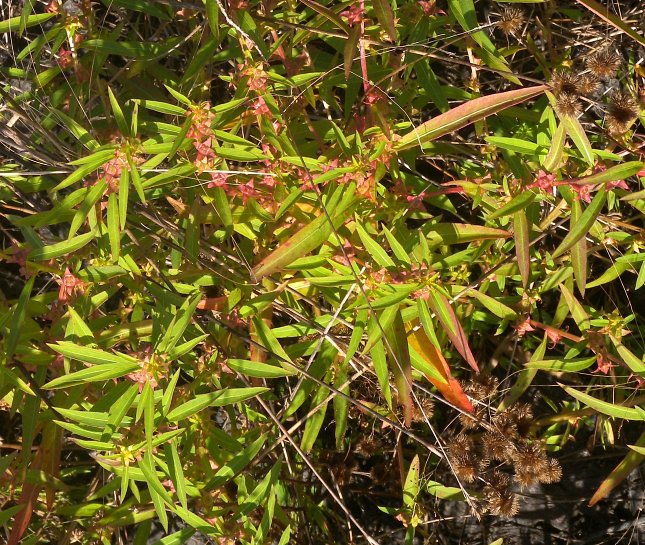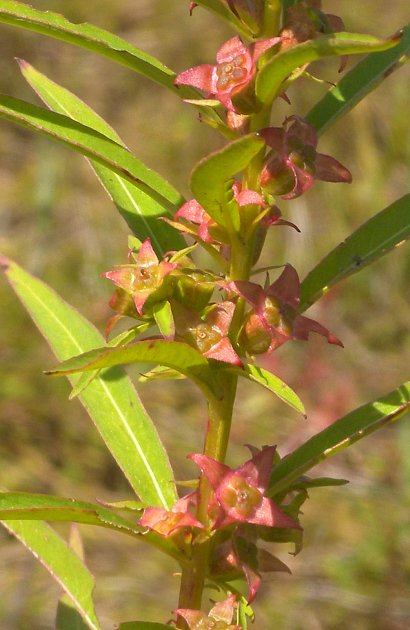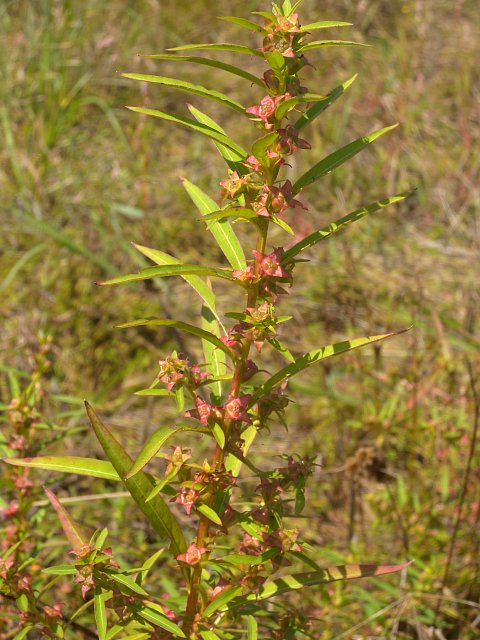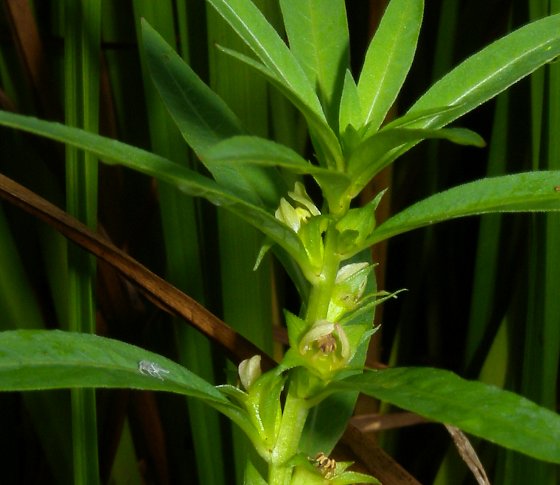False Loosestrife
Ludwigia polycarpa
Evening Primrose family (Onagraceae)
Ludwigia polycarpa
Evening Primrose family (Onagraceae)
Description:
This herbaceous perennial plant is 1–2½' (30–75 cm.) tall at maturity
with ascending to erect leafy stems that are either unbranched or
sparingly branched toward the bottom. The stems are light whitish green
to pink
(depending on maturity and sun exposure), hairless (or nearly so), and
4-angled. Abundant alternate leaves occur along the entire length of
each stem; these leaves are widely spreading to ascending. Individual
leaves are 1½–4" (4–10 cm.) long and 3–10 mm. (less than ½") across;
they are linear-elliptic in shape, toothless along their margins, and
either short-petioled or sessile. The upper and lower leaf surfaces are
light green to dark green (depending on sun exposure) and hairless (or
nearly so). Short lateral shoots with secondary leaves are sometimes
produced from the axils of the primary leaves; these secondary leaves
are similar in appearance to the primary leaves, except they are
smaller in size. Small solitary flowers are produced from the axils of
the lower-middle to upper leaves, blooming sequentially as they
develop; they are sessile or nearly so.

Individual flowers have a short-tubular green to light pink calyx with 4 spreading lobes, either zero or 4 petals (petals are produced rarely), 4 short stamens, and a 4-chambered pistil with a short style and knobby stigma. This pistil can be green, light yellow, or light pink on top, depending on its maturity and light exposure. The tubular calyx base is 4–6 mm. long and bluntly 4-angled, while its spreading lobes are 3–5 mm. long and deltate (triangular) in shape. When the petals are present, they are 1–2 mm. long, green or greenish yellow, and obovate in shape with tapered clawed bases; they curve in upward and inward, partially protecting the reproductive organs of the flower. They soon become discolored white and wither away. The anthers are initially light yellow, but later become brown before dropping away. The blooming period occurs from mid-summer into autumn, lasting about 1½–2 months for a colony of plants. In the absence of cross-pollination, the flowers can self-pollinate. Afterwards, the calyces containing their maturing seed capsules (fruits) enlarge in size slightly, and eventually turn brown, at which time they split open irregularly to release the numerous tiny seeds (about 0.5 mm. long). These seeds are small enough to be blown about by the wind or carried by water currents. The root system is shallow and fibrous, sometimes forming clonal offsets or stolons from the base of the plant.

Cultivation: The preference is light shade to full sun, wet to moist conditions (including temporary standing water), and soil containing muck, sand, silt, and/or abundant organic matter.
Range & Habitat: False Loosestrife occurs occasionally throughout Illinois in scattered locations (see Distribution Map), where it is native. This plant is found primarily in the north-central states in the US. Habitats include typical marshes, sandy marshes, borders of ponds and slow-moving streams, edges of sloughs, wet black soil prairies, wet clay prairies, wet sand prairies, swales in various prairies, soggy openings in bottomland woodlands, swamps, and ditches. This plant adapts to a variety of disturbed to high quality wetlands, although more commonly the latter.

Faunal Associations: Even though the non-showy flowers rarely have petals, they still provide nectar and pollen to flower-visiting insects. False Loosestrife has been observed to attract Halictid bees (mainly Lasioglossum spp.), miscellaneous wasps, miscellaneous flies, and ants to its flowers (Robertson, 1929; Wilhelm & Rericha, 2017). Other insects feed destructively on the foliage and other parts of False Loosestrife and other Ludwigia spp. These insect feeders include a flea beetle (Altica ligata), several weevils (Acanthoscelidius acephalus, Parauleutes nebulosus, Perigaster cretura), and such moths as the Pearly Wood Nymph (Eudryas unio) and Banded Sphinx (Eumorpha fasciatus); see Wilhelm & Rericha (2017), Wagner (2005), and the Natural History Museum website (2010).
Photographic Location: A moist swale in a sand prairie and a sandy marsh at Bonnie's Prairie Nature Preserve in Iroquois County, Illinois.

Comments: This wetland plant, which is largely found in the Midwestern states of the US, has received very little attention, even though it can become fairly large in size. This is largely because its flowers are not showy. In this regard, it has a similar appearance to two other Ludwigia spp. with non-showy flowers, namely Globe-fruited Primrose-willow (Ludwigia sphaerocarpum) and Cylindric-fruited Primrose-willow (Ludwigia glandulosa). These species can be distinguished from False Loosestrife by the shape of their respective calyces. Globe-fruited Primrose-willow has globoid-shaped calyx bases that are non-angular and about as wide as they are tall. In contrast, Cylindric-fruited Primrose-rose Willow has long-tubular calyces that are 4-angled; they are 3–4 times as long as they are across. False Loosestrife, in contrast, has bluntly 4-angled calyces that are 1.25–2 times as long as they are across. Cylindric-fruited Primrose-willow is a southeastern species that only occurs in southern Illinois, while Globe-fruited Primrose-willow is found primarily along Atlantic coastal areas and the Gulf of Mexico. However, outlier populations of this species also occur in the vicinity of southern Lake Michigan, primarily in sandy wetlands; this species has been reported from northeast Illinois. Another species that is better-known, Seedbox (Ludwigia alternifolia), has similar foliage, but its flowers have 4 large yellow petals and its mature fruits are cube-shaped.

Individual flowers have a short-tubular green to light pink calyx with 4 spreading lobes, either zero or 4 petals (petals are produced rarely), 4 short stamens, and a 4-chambered pistil with a short style and knobby stigma. This pistil can be green, light yellow, or light pink on top, depending on its maturity and light exposure. The tubular calyx base is 4–6 mm. long and bluntly 4-angled, while its spreading lobes are 3–5 mm. long and deltate (triangular) in shape. When the petals are present, they are 1–2 mm. long, green or greenish yellow, and obovate in shape with tapered clawed bases; they curve in upward and inward, partially protecting the reproductive organs of the flower. They soon become discolored white and wither away. The anthers are initially light yellow, but later become brown before dropping away. The blooming period occurs from mid-summer into autumn, lasting about 1½–2 months for a colony of plants. In the absence of cross-pollination, the flowers can self-pollinate. Afterwards, the calyces containing their maturing seed capsules (fruits) enlarge in size slightly, and eventually turn brown, at which time they split open irregularly to release the numerous tiny seeds (about 0.5 mm. long). These seeds are small enough to be blown about by the wind or carried by water currents. The root system is shallow and fibrous, sometimes forming clonal offsets or stolons from the base of the plant.

Cultivation: The preference is light shade to full sun, wet to moist conditions (including temporary standing water), and soil containing muck, sand, silt, and/or abundant organic matter.
Range & Habitat: False Loosestrife occurs occasionally throughout Illinois in scattered locations (see Distribution Map), where it is native. This plant is found primarily in the north-central states in the US. Habitats include typical marshes, sandy marshes, borders of ponds and slow-moving streams, edges of sloughs, wet black soil prairies, wet clay prairies, wet sand prairies, swales in various prairies, soggy openings in bottomland woodlands, swamps, and ditches. This plant adapts to a variety of disturbed to high quality wetlands, although more commonly the latter.

Faunal Associations: Even though the non-showy flowers rarely have petals, they still provide nectar and pollen to flower-visiting insects. False Loosestrife has been observed to attract Halictid bees (mainly Lasioglossum spp.), miscellaneous wasps, miscellaneous flies, and ants to its flowers (Robertson, 1929; Wilhelm & Rericha, 2017). Other insects feed destructively on the foliage and other parts of False Loosestrife and other Ludwigia spp. These insect feeders include a flea beetle (Altica ligata), several weevils (Acanthoscelidius acephalus, Parauleutes nebulosus, Perigaster cretura), and such moths as the Pearly Wood Nymph (Eudryas unio) and Banded Sphinx (Eumorpha fasciatus); see Wilhelm & Rericha (2017), Wagner (2005), and the Natural History Museum website (2010).
Photographic Location: A moist swale in a sand prairie and a sandy marsh at Bonnie's Prairie Nature Preserve in Iroquois County, Illinois.

Comments: This wetland plant, which is largely found in the Midwestern states of the US, has received very little attention, even though it can become fairly large in size. This is largely because its flowers are not showy. In this regard, it has a similar appearance to two other Ludwigia spp. with non-showy flowers, namely Globe-fruited Primrose-willow (Ludwigia sphaerocarpum) and Cylindric-fruited Primrose-willow (Ludwigia glandulosa). These species can be distinguished from False Loosestrife by the shape of their respective calyces. Globe-fruited Primrose-willow has globoid-shaped calyx bases that are non-angular and about as wide as they are tall. In contrast, Cylindric-fruited Primrose-rose Willow has long-tubular calyces that are 4-angled; they are 3–4 times as long as they are across. False Loosestrife, in contrast, has bluntly 4-angled calyces that are 1.25–2 times as long as they are across. Cylindric-fruited Primrose-willow is a southeastern species that only occurs in southern Illinois, while Globe-fruited Primrose-willow is found primarily along Atlantic coastal areas and the Gulf of Mexico. However, outlier populations of this species also occur in the vicinity of southern Lake Michigan, primarily in sandy wetlands; this species has been reported from northeast Illinois. Another species that is better-known, Seedbox (Ludwigia alternifolia), has similar foliage, but its flowers have 4 large yellow petals and its mature fruits are cube-shaped.